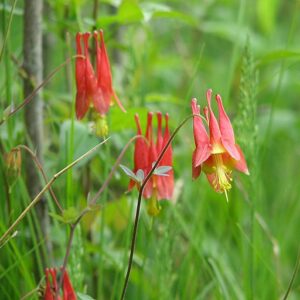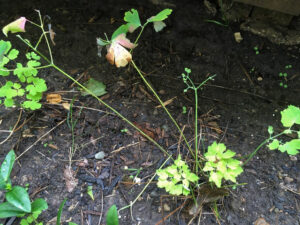 NATIVES TO KNOW
NATIVES TO KNOW
Wild Columbine
Aquilegia canadensis
By Linda Shuster, WORC member
Wild Columbine is also known as Eastern Columbine, Eastern Red Columbine, Canadian Columbine, and Wild Red Columbine. It is an herbaceous perennial that is a member of the buttercup (Ranunculaceae) family. The genus name, Aquilegia, is said to be derived from the Latin word for eagle (aquila), because the plant’s petals were thought to resemble eagle’s claws. Wild Columbine is found across Canada from Saskatchewan to Nova Scotia, as far south in the U.S. as Florida, west to Arkansas and Texas, and north to North Dakota. Habitats include deciduous or mixed forests, particularly at forest borders, roadsides, river banks, rocky slopes, and, occasionally, swamps. According to the University of Michigan Herbarium, it is found in nearly every county in Michigan.
 Wild Columbine grows to a height of 1-3’ with few branches. Initially, only basal leaves are produced, but alternate leaves occur along the stems as the plant grows. The leaves are compound in groups of three leaflets that are up to 3” long and 2” across. These leaflets are divided into three lobes, and the lobes may be further divided into small ”teeth.” The foliage is very attractive, even when the plants are not blooming. The plant produces 1-2” flowers that hang down from the stalk. They have 5 red sepals and 5 yellow petals. The anthers of the stamens are a bright yellow color. The plant typically flowers from May through June. The flowers are replaced by 5 pod-shaped follicles that split to release shiny black seeds. The roots are fibrous, but the plant occasionally produces rhizomes. North Carolina State University Extension and Longwood Gardens partnered to produce a YouTube video on Wild Columbine identification, which can be found here.
Wild Columbine grows to a height of 1-3’ with few branches. Initially, only basal leaves are produced, but alternate leaves occur along the stems as the plant grows. The leaves are compound in groups of three leaflets that are up to 3” long and 2” across. These leaflets are divided into three lobes, and the lobes may be further divided into small ”teeth.” The foliage is very attractive, even when the plants are not blooming. The plant produces 1-2” flowers that hang down from the stalk. They have 5 red sepals and 5 yellow petals. The anthers of the stamens are a bright yellow color. The plant typically flowers from May through June. The flowers are replaced by 5 pod-shaped follicles that split to release shiny black seeds. The roots are fibrous, but the plant occasionally produces rhizomes. North Carolina State University Extension and Longwood Gardens partnered to produce a YouTube video on Wild Columbine identification, which can be found here.
Wild Columbine generally prefers partial shade. More mature plants can tolerate full sun, particularly if the moisture is sufficient. Although it can tolerate a variety of soil types if they are well-drained, it prefers rich, loamy soil.
The University of Michigan Herbarium notes that Wild Columbine is one of the few plants in our local flora that is pollinated by hummingbirds, which they visit for its nectar. It is also visited by bumblebees and hawk moths for the nectar and by other bees for its pollen. Native Columbine leaf miner larvae (e.g., Phytomyza aquilegivora) leave grayish colored trails in the leaves. The mature leaf miner adults are a small, dark-colored fly. The female deposits her eggs on the plant, and when the larvae emerge, they tunnel through the upper and lower surfaces of the leaves, feeding on the tissue. Unless the infestation is severe, the damage is mainly cosmetic. Wild Columbine is a larval host plant for the native Columbine Duskywing moth (Erynnis lucilius) whose larvae feed on the leaves. It is not clear how abundant these moths are in Michigan.
 The non-native Columbine sawfly (Pristiphora rufipes) was introduced from Europe and has been described as a “voracious pest” on Columbine. These sawflies lay their eggs on the plant, and when the larvae emerge, they begin to feed on the leaves. The larvae, which look like tiny green worms, can completely defoliate the plant (see photo at left). After they have finished feeding, they drop off and pupate in the leaf litter. Although the plants can recover to some degree and produce new leaves that same season, it is not clear whether they can recover from repeated, yearly damage. Control is through physical removal of the larvae; however, despite trying to monitor the plants regularly and removing as many as 30 larvae in an evening, our plants were completely defoliated. The native Columbine Duskywing moth larvae and the non-native Columbine Sawfly larvae look similar, but the Duskywing moth larvae have a brown head, while the Sawfly larvae are entirely green.
The non-native Columbine sawfly (Pristiphora rufipes) was introduced from Europe and has been described as a “voracious pest” on Columbine. These sawflies lay their eggs on the plant, and when the larvae emerge, they begin to feed on the leaves. The larvae, which look like tiny green worms, can completely defoliate the plant (see photo at left). After they have finished feeding, they drop off and pupate in the leaf litter. Although the plants can recover to some degree and produce new leaves that same season, it is not clear whether they can recover from repeated, yearly damage. Control is through physical removal of the larvae; however, despite trying to monitor the plants regularly and removing as many as 30 larvae in an evening, our plants were completely defoliated. The native Columbine Duskywing moth larvae and the non-native Columbine Sawfly larvae look similar, but the Duskywing moth larvae have a brown head, while the Sawfly larvae are entirely green.
Like other members of the Ranunculaceae family, Columbine contains toxic substances, causing vomiting and diarrhea if ingested. However, its toxicity is minor, unlike some other members of the family, including Actea (baneberries). This toxicity makes it less palatable to mammalian species, such as rabbits and deer. Toxicity increases as larger amounts of the plant are ingested. According to the U.S. Forest Service, Native Americans use parts of the plant to create infusions to treat a variety of health conditions, including heart, kidney, and bladder problems, as well as headache and fever. Moreover, Aquilegia species have been used for thousands of years in traditional Chinese medicine, and researchers currently are working to understand the mechanisms underlying their effectiveness.
In summary, Wild Columbine is a lovely addition to the native garden. It is generally easy to care for and when it is free of non-native pests, such as the Columbine sawfly, both its flowers and foliage contribute to the beauty of the garden.
Sources:
- National Audubon Society (2001). Field Guide to Wildflowers (rev ed.). Alfred Knopf.
- University of Wisconsin Horticulture: https://hort.extension.wisc.edu/articles/eastern-red-columbine-aquilegia-canadensis/
- University of Michigan Herbarium: https://michiganflora.net/species.aspx?id=2362
- Hilty, J. Illinois Wildflowers: http://www.illinoiswildflowers.info/woodland/plants/wild_columbine.htm
- Looney C, Smith DR, Collman SJ, Langor DW, Peterson MA (2016) Sawflies (Hymenoptera, Symphyta) newly recorded from Washington State. Journal of Hymenoptera Research, 49, 129–159. doi: 10.3897/JHR.49.7104
- University of California Safe and Poisonous Garden Plants: https://ucanr.edu/sites/poisonous_safe_plants/Toxic_Plants_by_common_Name_659/
- Toxicity: https://www.lakeforest.edu/academics/majors-and-minors/environmental-studies/aquilegia-canadensis-(wild-columbine/eastern-red-columbine)-ranunculaceae
- Toxicity: https://poisonousplants.ansci.cornell.edu/toxicagents/ranunculoside.html#cont
- Yu, Y., Yi, Z. B., & Liang, Y. Z. (2007). Validate antibacterial mode and find main bioactive components of traditional Chinese medicine Aquilegia oxysepala. Bioorganic & Medicinal Chemistry Letters, 17(7), 1855–1859. https://doi.org/10.1016/j.bmcl.2007.01.032
Image Credits:
- Top Columbine flower photo: https://commons.wikimedia.org/wiki/File:Wild_Columbine_3.JPG
- Two Columbine foliage photos: Linda Shuster
